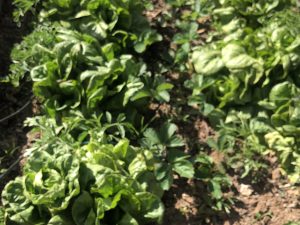The term food forest gardening is a description of a type of low-maintenance food production gardening. The underlying thread is sustainability, earth-friendly land management that combines elements of permaculture (permanent agriculture that works with nature) and organic gardening.
A food forest is planted as a layered system starting with the tallest trees, moving down through layers to foreground cover crops. Planting a food forest mimics how a natural forest develops, except that you fill the layers with food plants that you like and that will feed your family. After the initial planting, not much work is required because the system maintains itself. This reduces the need for pesticides, herbicides, weeding, crop rotation, tilling, mowing and digging. The system also protects the soil, recycles nutrients, conserves water and decreases or eliminates dangerous chemicals.
Key to this growing plan is planting as many perennial plants as possible in each area. Start with a few large trees spaced widely enough that plenty of light reaches the lower layers. Nuts and fruits that you like and are suited to your growing zone can be interplanted with edible or medicinal shrubs, flowers and vines. Include self-seeding flowers attractive to pollinators.
Some plants that fit well into the food forest plan are nut trees (almond, walnut, pecan) or an avocado tree, perhaps. Next, the fruit tree layer could include grafted dwarf varieties, making it possible to plant several kinds. Examples of these would be apple, fig, stone fruit or the many varieties of citrus. Follow this with your preference of shrubs such as rhubarb, asparagus and artichoke. The next layer is fruiting vines and berries which include blueberries, raspberries, grapes, peas and beans.
The final layers include root vegetables followed by cover crops containing an herb layer. On the outer fringes or in containers you can plant root crops of garlic and onion. Herbs and pollinator flowers will attract bees and butterflies to your garden. Potatoes do well in containers and grow bags. Let your plants self-seed and see which ones thrive. For additional suggestions, contact your extension office.
A food forest can be as big or small as you like. A small yard or a small part of a yard is big enough. Start with one of each layer plant and see what works. You don’t have to do your whole yard area or have a master landscape plan. Start and see what works, building in succession next year and the year after.
Gardening with a sense of ecosystems can work for all organisms including plants, animals, insects and us, creating a relationship between people, plants and Mother Nature. It’s a holistic way of thinking and living in harmony with nature. If we take care of the earth, it will take care of us. Sustainability, abundance, community, and ecology harmonizing with nature is a goal to strive towards for our future.
Diane Miller is a University of California Cooperative Extension Master Gardener of Tuolumne County.

